
Jose Marti Memorial in Revolution Square (Plaza de Revolucion)
It’s been two months since I returned from my week in Cuba, traveling as part of the Hedwig Dances Touch Tour 2019 – the company’s fifth such curated immersion in the country’s art, dance, food, districts, monuments, history and more. There seems no simple way, no word or pithy phrase presents itself to me, to characterize my experience while there.
So, I begin with a few photographs from the first day and a few things my fellow travelers and I learned from our tour guide, Yunelbis. She would become a central figure during our week together, gently sharing information that enlarged our understanding even as she would offer us a different lens with which to view her country’s historical and political events, alongside Cuba’s vibrant arts culture, as well as the many dimensions of its current racial, agricultural, architectural and economic realities.
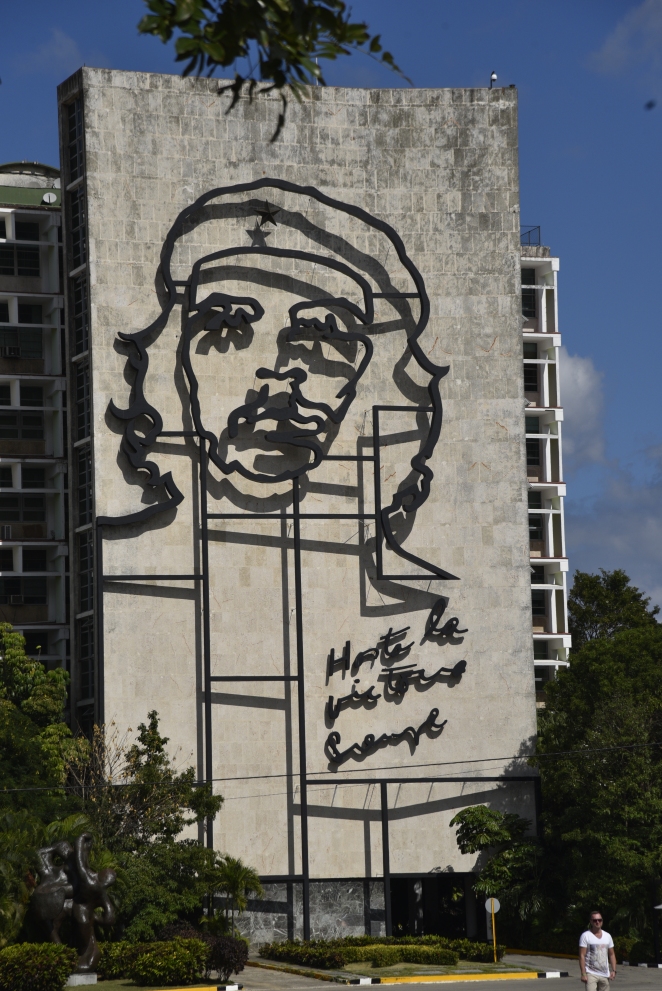
Che Guevara in Revolution Square, Cuba. “Hasta la victoria Siempre” or “Until the eternal victory”

Camilo Cienfuegos “Vas bien, Fidel” – “You do well, Fidel”
We noted that this location was well visited by many tour guides with their groups. We came to understand that the embargo has made tourism the most important means for Cuba to build its coffers, as long as the embargo prevents the export of any Cuban good to the USA.

This became a familiar site – the gathering of the travellers around Yunelbis, our guide, as she explained the significance of our surroundings even as she offered ways that we might navigate the terrain. How to tip, how to politely decline, how to negotiate a price, and so many more helpful insights. I was fascinated by our foot gear and our stances.

Light poles sans bulbs. So often I would see these giant forms, reminiscent of divining rods, that seemed to have no function. My guess is that they are light poles missing the bulbs – perhaps because of the ongoing shortages of parts of any and all kinds in the country, and perhaps because of the country’s seriously decaying power and water infrastructures.
On one side of Revolution Square was a large parking lot that was filled with the legendary Cuban taxis. These beautifully kept antique autos from the 50’s and 60’s were fascinating to behold. Yunelbis said that the many brilliant colors on the vehicles could be traced back to another reality of the strapped economy: Discontinued auto paints would be purchased in lots for reduced prices and then, once in the country, the word went out and the paints were snapped up by those wanting to spruce up their old automobiles. The embargo is the underlying cause that no new automobiles can come into the country – no one can afford them. The embargo makes everything that comes into the country very expensive because the ships that come in laden with goods must go out empty – hence the return trip is major lost revenue. To make up for the loss, the ships charge more to the importers, who make up that additional cost by charging more for the goods being shipped in.


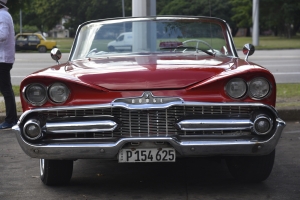
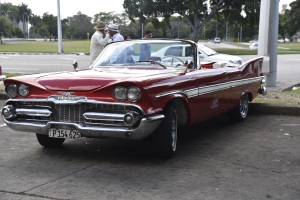


Melia Cohiba 17th Floor Lounge daily offerings for weary guests
The group had been traveling by shuttles, busses, and planes for the better part of two days to get to this point on Day One in Cuba. My roommate Marcia and I had caught the 7:30 am shuttle from our Miami hotel to get to the airport with enough time to go through customs and then catch our flight to Cuba with the rest of our group. After our extended walk-around of Revolution Square we re-boarded our bus, travelled across town, and then gratefully arrived at Melia Cohiba to check in, have a snack, accompanied by our first of many welcome Mojitos, refresh and then off to our first dinner in our first paladar.
“Paladares are a uniquely Cuban phenomenon,” said my tour packet. After the revolution and the mass exodus of so many people and the resultant economic crash, these private enterprises became an increasingly popular way for people to earn a few extra dollars by turning their homes into restaurants. We were also advised that all payments to the restaurants are in CUCs, (Cuban Units of Currency that are used exclusively by tourists to the country), which are then turned into the government along with earnings reports, from which the government takes a percentage and converts the CUCs into Cuban pesos, the local currency used by the citizenry. That evening, Atelier would offer us our first experience of this uniquely Cuban phenomenon.

Walking into the foyer on the ground floor, we see the staircase to the second level where our meal will be served. Marilyn, Marcia and Maray lead the way, while Melinda and Daniel stand on the threshold.
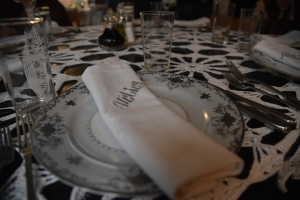
The antique china and silver, the embroidered linen napkins and the crocheted open-work table cloth signaled to us that every detail of our meal would be thoughtfully attended to.
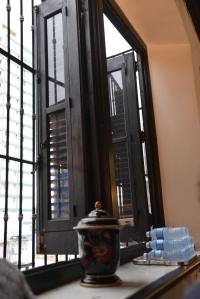


At dinner that evening we each stood in turn to introduce ourselves to the others in the group. We were sixteen members in all; many from Chicago, one from Omaha, one from New York City, one from upstate New York, one from Washington DC, and one from California. We began to bond that night and through the rest of the trip we experienced an enriching sense of connection, delight in shared discoveries, and growing mutual appreciation. We arrived at Atelier when the light was still strong. When we left it was dark. After returning to our hotel, which overlooks the Malecon, a small group of us decided to brave the 4-lane highway to get to the ocean side.

The Malecon.
Look for more entries in the upcoming days and weeks on my experiences on this trip. I hope to understand better as I share the images and write about the days, the people and the discoveries.
